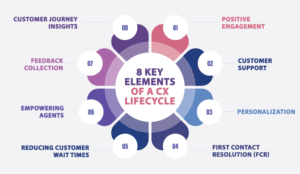We take a look at the key elements of a Customer Experience Lifecycle and how you can improve it.
A Definition of the Customer Experience Lifecycle
The Customer Experience Lifecycle (also known as the CX Lifecycle, Customer Life Cycle, or Customer Lifetime Cycle) refers to the stages that a customer goes through when interacting with a brand, product, or service, and making multiple purchases across a longer period of time. Improving the CX lifecycle involves enhancing the customer’s satisfaction, loyalty, and overall perception of the brand.
Note, the term differs from other widely used terms such as customer journey and conversion funnel. This is because a customer journey is about the touch points a customer experiences when using a particular service or buying one product, whilst a conversion funnel is about the steps involved in acquiring a customer.
The 8 Key Elements of a Customer Experience Lifecycle
Not sure where to start? Here are the 8 key elements of customer lifecycles…
1. Positive Engagement
Contact centre agents are often the first point of contact for customers. Ensure that interactions are positive, empathetic, and focused on understanding customer needs.
Implement a multichannel approach, allowing customers to reach out through their preferred communication channels (phone, email, chat, and social media).

2. Customer Support
The contact centre plays a crucial role in providing timely and accurate support. Empower agents with comprehensive product knowledge and tools to efficiently resolve customer issues.
Offer self-service options in the contact centre, such as knowledge bases on the website and interactive voice response (IVR) systems, for customers who prefer resolving issues independently.
3. Personalization
Equip agents with customer history and data to personalize interactions. Address customers by name and reference previous interactions to create a seamless experience.
Use data analytics to predict customer needs and provide proactive solutions.
4. First Contact Resolution (FCR)
Prioritize resolving issues in the first interaction to minimize customer effort and frustration.
Invest in agent training to enhance problem-solving skills and empower them to handle a wide range of customer enquiries.
For more information on FCR, read our article: What Is First Contact Resolution? – With Formula and Expert Best Practices
5. Reducing Customer Wait Times
Implement efficient call routing and queuing systems to minimize wait times.
Provide customers with estimated wait times and offer callbacks to avoid keeping them on hold.
6. Empowering Agents
Foster a positive working environment for contact centre agents, as their job satisfaction directly impacts customer interactions.
Offer ongoing training and skills development to ensure agents are equipped to handle complex and evolving customer needs.
To discover what an empowered employee looks like in the contact centre, read our article: What Does Employee Empowerment REALLY Mean?
7. Feedback Collection
Actively seek customer and employee feedback to gauge satisfaction levels and identify areas for improvement.
Use feedback to make real-time adjustments to agent behaviour and processes.
To learn how to involve the frontline in operational and strategic decision-making, read our article: Involve Agents in Operations and Strategy
8. Customer Journey Insights
Use contact centre data to map customer journeys and identify pain points and opportunities for enhancing the experience.
Analyse patterns and trends in customer interactions to better understand their needs and behaviours.
A deeper understanding of your customers can improve your contact centre. For more information, read our article: Really Understand Why Your Customers Are Contacting You
How to Improve the CX Lifecycle in the Contact Centre
There are several strategies you can try to help improve the Customer Life Cycle in the contact centre, including:
Customer Life Cycle Marketing
Why not try customer life cycle marketing to boost your CX Lifecycle?
This is the process of adjusting and personalising key messaging for customers at various points in the customer life cycle to improve their overall perception of the brand and their experience.
Quality Monitoring and Coaching
To boost your customer lifecycles, regularly monitor and evaluate interactions to ensure consistency and quality in agent responses.
Provide constructive feedback and coaching sessions to help agents enhance their skills and customer interaction techniques.

Empathy and Active Listening
Train agents to practise active listening and express genuine empathy toward customer concerns.
Encourage agents to acknowledge customer emotions and provide reassurance.
Predictive Analytics
Utilize predictive analytics to anticipate customer needs and issues, allowing agents to proactively address them.
Implement AI-powered solutions that suggest responses based on historical data and current context.
Omnichannel Integration
Integrate various communication channels into a unified platform, enabling seamless transitions between channels whilst maintaining context.
Ensure consistent responses and information across all channels.
For expert advice on why omnichannel customer experience is so important, read our article: Why Is Omnichannel Customer Service Important?
Employee Wellbeing
Recognize the challenging nature of contact centre work and prioritize employee wellbeing to help improve your customer lifecycles.
Offer support mechanisms, stress management resources, and career growth opportunities for agents. You can also use data to drive your wellbeing strategy, as Dr. Phoebe Asquith at Sabio explains in this article.
Continuous Improvement
Regularly review and refine contact centre processes based on customer feedback and changing preferences.
Embrace new technologies and trends to stay ahead in meeting customer expectations.
Technology Enhancement
Invest in advanced contact centre technologies, such as chatbots and AI-driven virtual assistants, to handle routine enquiries and free up agents for more complex interactions.
Agents need the right resources to provide the best possible service. To learn more, read our article: Give Agents the Right Tools to Do Their Job
Real-Time Assistance
Implement real-time collaboration tools that enable agents to seek assistance from experts within the organization to resolve intricate issues promptly.
Leave a Positive Lasting Impression
In summary, the contact centre plays a pivotal role in shaping the overall CX lifecycle and determining customer satisfaction.
By focusing on personalized interactions, proactive problem-solving, employee empowerment, and continuous improvement, businesses can create a contact centre that not only resolves customer issues, but also leaves a positive, lasting impression.
We have a number of other great articles on Customer Experience (CX) that you should read next:
- 10 Metrics to Help You Measure the Customer Experience
- The Top 10 Customer Experience (CX) KPIs for 2023
- How to Calculate Customer Lifetime Value – The Formula
Author: Jonty Pearce
Reviewed by: Megan Jones
Published On: 22nd Sep 2023 - Last modified: 25th Jul 2024
Read more about - Customer Service Strategy, Customer Satisfaction (CSAT), Customer Service, CX, Sabio








































